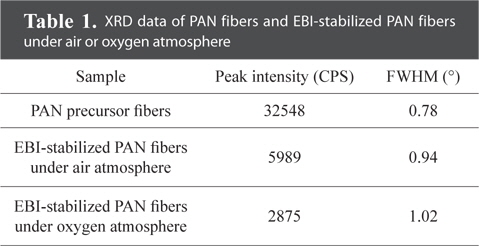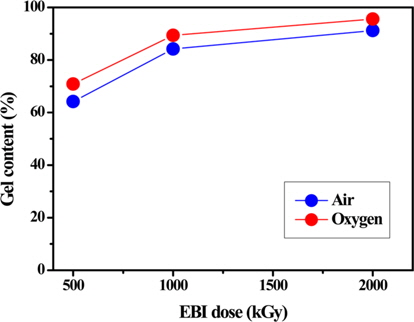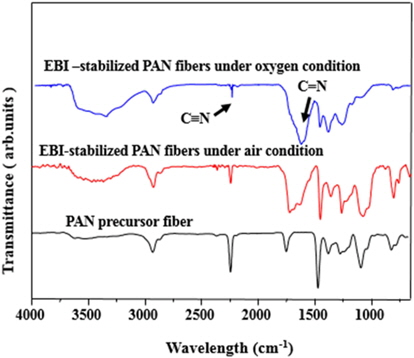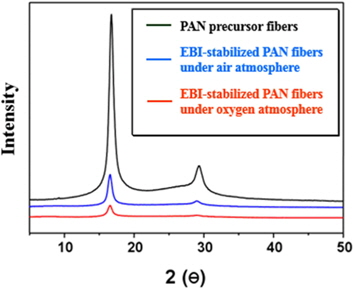



In order to produce high-performance carbon fibers from polyacrylonitrile (PAN) precursor fibers, the process of stabilization plays an important role [1-10]. In this process, linear polymers of C≡N groups in the PAN fibers are converted into ladder polymers by various methods, including cyclization, cross-linking, dehydrogenation, and oxidation [11,12]. These ladder structures enhance the thermal stability of the PAN fibers, thus preventing them from melting during carbonization at temperatures over 1000℃. Hence, the parameters of the stabilization process are expected to have a strong impact on the strength of the resulting carbon fibers.
Electron beam irradiation (EBI) has been widely applied in the modification of various materials in the absence of solvents or additives, at room temperature, due to its ability to induce a variety of changes in properties, through chain scissioning, polymerization, and crosslinking. In the past, many researchers focused on thermal stabilization of PAN fibers to produce high-performance carbon fibers. However, the use of EBI as a stabilization process [13-18] is currently becoming widespread for various reasons, including lower energy consumption and a reduced stabilization time. In particular, the control of various atmosphere conditions during the stabilization process can accelerate the cyclization reaction.
In this study, PAN fibers were irradiated under different conditions of air and oxygen atmosphere at room temperature. The PAN fibers stabilized by EBI under both atmosphere conditions were characterized by gel fraction, Fourier-transform infrared spectroscopy (FT-IR), and X-ray diffraction (XRD) analysis.
2.1 Materials and EBI stabilization
Raw PAN fibers were obtained from Anshan East Asia Co., Ltd., China. The obtained PAN fibers were irradiated with 2 MGy using an EB accelerator at an accelerating voltage of 1.14 MeV with a beam current of 4 mA under the two types of atmosphere.
Dimethyl-formamide (DMF) was used as a solvent to measure the gel fraction of the EBI-stabilized PAN fibers. The samples were extracted in DMF at boiling temperature for 24 h. The residual gel contents were dried in vacuum at 80℃ for 48 h. The gel fraction determination was defined as the weight percent of insoluble parts according to the following equation:
FT-IR analyses were performed using a Nicolet 7700 spectrometer with the KBr method to determine changes in the functional groups within the PAN fibers. The wavelengths used were in the range of 4000-650 cm−1 and the spectra obtained contained the results of 30 scans at a spectrophotometer resolution of 8 cm−1. An X-ray diffractometer (RIGADU D/MAX-2500) with CuKα radiation, generated at 40 kV and 30 mA, was used over the 2
Fig. 1 shows the gel fraction values which account for the degree of cyclization of the EBI-stabilized PAN fibers, according to the different EBI doses applied under air or oxygen conditions. From Fig. 1 it is apparent that the gel content of the EBI-stabilized PAN fibers gradually increased with increasing EBI dose under both air and oxygen conditions. It is also evident that the specific atmosphere condition used clearly affected the degree of cyclization in the PAN fibers. In fact, the degree of cyclization in the PAN fibers stabilized by EBI under an oxygen atmosphere were higher than those in the corresponding PAN fibers stabilized under an air atmosphere. In the former case, the maximum gel content was approximately 95.6% at 2000 kGy of EBI dose. This outcome can be due to an acceleration of the conversion of C≡N groups into C=N groups brought about through oxygen uptake.
In order to understand the conversion of C≡N groups into C=N groups in EBI-stabilized PAN fibers, we conducted FT-IR analyses, as depicted in Fig. 2. In the case of the PAN precursor fibers, the peaks for the C-H and C≡N stretching vibrations were observed at 1451 cm−1 and 2244 cm−1, respectively. In the presence of an oxygen atmosphere, the intensities of these peaks decreased compared to their intensities in an air atmosphere. However, the intensity of a new peak at 1628 cm−1, which was attributed to the C=N absorption mode, increased gradually in the following order: PAN precursor fibers < PAN fibers stabilized by EBI under air atmosphere < PAN fibers stabilized by EBI under oxygen atmosphere. These results provide evidence that an oxygen atmosphere can greatly enhance the cyclization degree during EBI-stabilization.
Fig. 3 exhibits the major changes in the EBI-stabilized PAN fibers according to the air or oxygen conditions used, as observed through the XRD spectra. These results are further summarized in Table 1. In Fig. 3, a major peak at a 2θ value of 16°-17° was associated with the (100) plane of a hexagonal structure, thus indicating the crystalline structure of the PAN fibers.
[Table 1.] XRD data of PAN fibers and EBI-stabilized PAN fibers under air or oxygen atmosphere

XRD data of PAN fibers and EBI-stabilized PAN fibers under air or oxygen atmosphere
As shown in Fig. 3 and Table 1, the intensity of the peak for EBI-stabilized PAN fibers largely decreased compared to the one for the PAN precursor fibers. Furthermore, the intensity of the peak for the PAN fibers stabilized by EBI under an oxygen atmosphere decreased more than that of the PAN fibers stabilized by EBI under an air atmosphere, while the full width at half maximum value increased. These results are due to an increase in amorphization by cyclization in the EBI-stabilized PAN fibers.
In conclusion, the PAN precursor fibers investigated in this study were stabilized by EBI under air or oxygen atmospheres. The gel contents of the EBI-stabilized PAN fibers at 2000 kGy under an oxygen atmosphere reached values of about 95%. From the FT-IR analysis, it was found that the increase in the intensity of the C≡N vibration peak at 2244 cm−1 and the decrease in the intensity of the C=N absorption peak at 1628 cm−1, which were more apparent for the PAN fibers stabilized by EBI under an oxygen atmosphere than for those stabilized under an air atmosphere, are highly correlated with the transformation of linear groups into cyclized groups. In the XRD analysis, the PAN fibers stabilized by EBI in the presence of oxygen display decreased peak intensities. These results may be an indication that the oxygen uptake in the PAN fibers causes a higher destruction of the crystalline regions due to an increase in the amorphous regions through cyclization.




